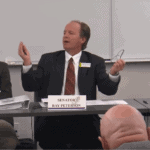“Recalibration” committee members slam Sheridan senator over bogus claims about Wyoming public school performance
[one_third last=”no” spacing=”yes” center_content=”no” hide_on_mobile=”no” background_color=”” background_image=”” background_repeat=”no-repeat” background_position=”left top” border_position=”all” border_size=”0px” border_color=”” border_style=”” padding=”” margin_top=”” margin_bottom=”” animation_type=”” animation_direction=”” animation_speed=”0.1″ class=”” id=””][fusion_text]Oct. 20, 2017
The Wyoming State Legislature, for all its shortcomings, is typically a polite group. Lawmakers tend to avoid making each other look bad.
But at last week’s School Finance “Recalibration” Committee meeting in Casper, a few committee members appeared to lose their patience when a state senator trotted out—for the umpteenth time—flatly inaccurate claims about Wyoming’s education system.
A small cadre that includes this senator has made it their mission to convince people that Wyoming’s schools do a bad job and cost too much, in hopes of justifying deep funding cuts to the state’s public education system.[/fusion_text][/one_third][two_third last=”yes” spacing=”yes” center_content=”no” hide_on_mobile=”no” background_color=”” background_image=”” background_repeat=”no-repeat” background_position=”left top” border_position=”all” border_size=”0px” border_color=”” border_style=”” padding=”” margin_top=”” margin_bottom=”” animation_type=”” animation_direction=”” animation_speed=”0.1″ class=”” id=””][fusion_text]

Sen. Hank Coe (R-Cody), having heard it a million times before, no longer bothers to mask his boredom as Sen. Kinskey blathers on about Wyoming public school performance.
[/fusion_text][/two_third][four_fifth last=”yes” spacing=”yes” center_content=”no” hide_on_mobile=”no” background_color=”” background_image=”” background_repeat=”no-repeat” background_position=”left top” border_position=”all” border_size=”0px” border_color=”” border_style=”” padding=”” margin_top=”” margin_bottom=”” animation_type=”” animation_direction=”” animation_speed=”0.1″ class=”” id=””][fusion_text]But not everyone is buying these lawmakers’ doom-and-gloom argument. The following exchange among “recalibration” committee members last week sheds light on the broader debate over education funding that will play out in the upcoming 2018 budget session, which will largely determine the fate of Wyoming public schools.
The Kinskey strategy: Repeat your bogus claim until it seems true
On Friday morning, Sen. Dave Kinskey (R-Sheridan) began the meeting by droning on about his favorite subject: How Wyoming doesn’t get enough “bang for its buck” when it comes to funding public schools.
“My question is why in Wyoming do we spend double what Utah spends and 40 percent or more than every state around us spends [on education], and yet our composite [National Assessment of Educational Progress] scores are virtually indistinguishable from our neighbors?” Kinskey said. “More importantly, what is the answer to getting more ‘bang for our buck’ educationally?”
Whenever he compares Wyoming to Utah, Kinskey never addresses the glaring fact that Utah—and literally every other American state besides Wyoming—contains a densely populated metropolitan area with a few hundred thousand people in it, which dramatically drives down per-student education costs. If you compare rural school districts in Utah with those in Wyoming, cost and performance are similar.
Kinskey went on to complain about Wyoming’s high school graduation rates and to generally characterize the state’s education system as an overpriced piece of garbage. He may have gone too far this time, or prattled on a bit too long, because other members of the committee, usually fairly reserved, took issue with his claims—and they brought data to counter his anecdotes. [You watch video of the full meeting here, courtesy of Wyoming PBS.][/fusion_text][/four_fifth][one_third last=”no” spacing=”yes” center_content=”no” hide_on_mobile=”no” background_color=”” background_image=”” background_repeat=”no-repeat” background_position=”left top” border_position=”all” border_size=”0px” border_color=”” border_style=”” padding=”” margin_top=”” margin_bottom=”” animation_type=”” animation_direction=”” animation_speed=”0.1″ class=”” id=””][fusion_text]“Our aggregated NAEP score in 2015 was fourth in the country”
Sen. Chris Rothfusss (D-Laramie) has challenged Kinskey’s assertions along these lines in the past. But last week he came with a full-fledged renunciation.
“I’m concerned with the concept being promoted that we’re not getting the ‘bang for our buck,’” Rothfuss said. “When you look at the data and the NAEP scores and you compare it to 10 years ago when we really started to fully fund education in Wyoming, we’re doing a lot better. We were at that time relatively indistinguishable from our neighbors in terms of performance and NAEP scores. But over the last 10 years, we’ve improved that dramatically to the point where, now, we are distinguishable from our neighbors.[/fusion_text][/one_third][two_third last=”yes” spacing=”yes” center_content=”no” hide_on_mobile=”no” background_color=”” background_image=”” background_repeat=”no-repeat” background_position=”left top” border_position=”all” border_size=”0px” border_color=”” border_style=”” padding=”” margin_top=”” margin_bottom=”” animation_type=”” animation_direction=”” animation_speed=”0.1″ class=”” id=””][fusion_text]

Sen. Rothfuss counters Kinskey, pointing out that the data refute the claim that Wyoming performs worse than it’s neighbors; furthermore, since the state decided to fully fund education 10 years ago, Wyoming has made dramatic improvements.
[/fusion_text][/two_third][four_fifth last=”yes” spacing=”yes” center_content=”no” hide_on_mobile=”no” background_color=”” background_image=”” background_repeat=”no-repeat” background_position=”left top” border_position=”all” border_size=”0px” border_color=”” border_style=”” padding=”” margin_top=”” margin_bottom=”” animation_type=”” animation_direction=”” animation_speed=”0.1″ class=”” id=””][fusion_text]“We’ve gotten to the point when our aggregated NAEP score in 2015 was fourth in the country; fourth behind three states—New Hampshire, Massachusetts, and Vermont—that spend as much or more as we do per student on education.
“So, anecdotally, we seem to think that we’re doing poorly, and we keep hearing that repeated over and over again. But it is not borne out by the data. Yes, we clearly want to improve our graduation rates. There are things we know we can do. But to continue to say that we’re not getting that ‘bang for our buck’ when we have dramatically improved our performance in a rural state with a transient population over the last decade is simply not accurate.”[/fusion_text][/four_fifth][one_third last=”no” spacing=”yes” center_content=”no” hide_on_mobile=”no” background_color=”” background_image=”” background_repeat=”no-repeat” background_position=”left top” border_position=”all” border_size=”0px” border_color=”” border_style=”” padding=”” margin_top=”” margin_bottom=”” animation_type=”” animation_direction=”” animation_speed=”0.1″ class=”” id=””][fusion_text]Wyoming schools surpass those in all other mining states
The Laramie Democrat wasn’t alone in refuting Kinskey’s bogus claims. Rep. Albert Sommers (R-Pinedale), who co-chairs the “recalibration” committee, also weighed in. He pointed out that Wyoming does exceptionally well in education among its fellow mining states.
“I, too, disagree with Senator Kinskey,” Sommers said. “If you think about education and outcomes, you first have to look at the demographics. In Wyoming, our demographics are really tied to the people who work in the mineral industry.[/fusion_text][/one_third][two_third last=”yes” spacing=”yes” center_content=”no” hide_on_mobile=”no” background_color=”” background_image=”” background_repeat=”no-repeat” background_position=”left top” border_position=”all” border_size=”0px” border_color=”” border_style=”” padding=”” margin_top=”” margin_bottom=”” animation_type=”” animation_direction=”” animation_speed=”0.1″ class=”” id=””][fusion_text]

Rep. Sommers further counters Kinskey, pointing out that Wyoming’s education performance far exceeds any other mining state’s in America.
[/fusion_text][/two_third][four_fifth last=”yes” spacing=”yes” center_content=”no” hide_on_mobile=”no” background_color=”” background_image=”” background_repeat=”no-repeat” background_position=”left top” border_position=”all” border_size=”0px” border_color=”” border_style=”” padding=”” margin_top=”” margin_bottom=”” animation_type=”” animation_direction=”” animation_speed=”0.1″ class=”” id=””][fusion_text]“If you look at us in terms of the percentage of our GDP that comes from mining, including oil and gas, Wyoming has the highest percent in the country. And, according to EdWeek, we’re rated 20th nationwide in educational achievement.”
He went on to compare Wyoming to the other most mineral-dependent U.S. states: “Alaska has the second highest percentage of its GDP related to mining. They’re ranked in [educational] achievement 45th. If you go to the third-ranking state, West Virginia, they’re ranked 48th in achievement. Remember, Wyoming’s 20th. If you go to the fourth-ranking state for minerals, Oklahoma, they’re ranked for achievement 39th. You go to the fifth ranking state, North Dakota, they’re ranked 34th. I can go on down the list and it’s a similar note.
“We pay more, we get more, and we do better than those states with similar demographics,” Sommers concluded. “I think this argument is getting old, and we can continue to pull these numbers out every meeting, and maybe we will. But I think we get the ‘bang for our buck.’”[/fusion_text][/four_fifth][one_third last=”no” spacing=”yes” center_content=”no” hide_on_mobile=”no” background_color=”” background_image=”” background_repeat=”no-repeat” background_position=”left top” border_position=”all” border_size=”0px” border_color=”” border_style=”” padding=”” margin_top=”” margin_bottom=”” animation_type=”” animation_direction=”” animation_speed=”0.1″ class=”” id=””][fusion_text]The highest graduation rate in the state’s history
Closing out this round of rebuttals was Rep. Steve Harshman (R-Casper), the Speaker of the House. Harshman has emerged as one of the most pragmatic and serious lawmakers among Legislative leadership when it comes to addressing the state’s education funding crisis. In the upcoming budget session, it appears the debate over education funding will largely pit Harshman, who seems to genuinely want to protect Wyoming public education, against Senate President Eli Bebout (R-Riverton), who says he’d like to see $200 million more cut from Wyoming public schools.[/fusion_text][/one_third][two_third last=”yes” spacing=”yes” center_content=”no” hide_on_mobile=”no” background_color=”” background_image=”” background_repeat=”no-repeat” background_position=”left top” border_position=”all” border_size=”0px” border_color=”” border_style=”” padding=”” margin_top=”” margin_bottom=”” animation_type=”” animation_direction=”” animation_speed=”0.1″ class=”” id=””][fusion_text]

Rep. Harshman noted that Kinskey had been cherry picking data to make Wyoming schools look bad: “I think the NAEP scores—you can take little averages out of context pretty easily. There’s a lot of NAEP scores where we’re one of the best in the world. I don’t hear much talk about that.”
[/fusion_text][/two_third][four_fifth last=”yes” spacing=”yes” center_content=”no” hide_on_mobile=”no” background_color=”” background_image=”” background_repeat=”no-repeat” background_position=”left top” border_position=”all” border_size=”0px” border_color=”” border_style=”” padding=”” margin_top=”” margin_bottom=”” animation_type=”” animation_direction=”” animation_speed=”0.1″ class=”” id=””][fusion_text]“There was a time in Wyoming, when some of us were growing up, when graduation rates were hovering right around 50 percent,” Harshman said. “Now, Wyoming has been up in the 80 percents for the past 10 years. That’s the highest in the state’s history. So I think there’s always more to that story. Do we want to do better? Absolutely. Have we done a lot better? Absolutely. I think the NAEP scores—you can take little averages out of context pretty easily. There’s a lot of NAEP scores where we’re one of the best in the world. I don’t hear much talk about that.
“We’ve done some incredible things in this state. I’m not going to apologize for that,” he continued. “Now, do we need to continuously look for efficiencies? Absolutely. But to kick this thing and to say that somehow we’ve done a poor job, and that Utah is the shining example, I don’t think so. Utah has more high school kids than we have population.
“With all due respect, I’ve sat and listened to this and listened to it—and I agree, let’s keep working on outcomes. But I don’t want to talk about anecdotes and having some kind of owner’s remorse where we’re going to waterboard ourselves, because we’ve done a great job with K-12 education.”
Sign up to receive Better Wyoming emails on our homepage, and follow us on Twitter and Facebook.[/fusion_text][/four_fifth]




Comments are closed.